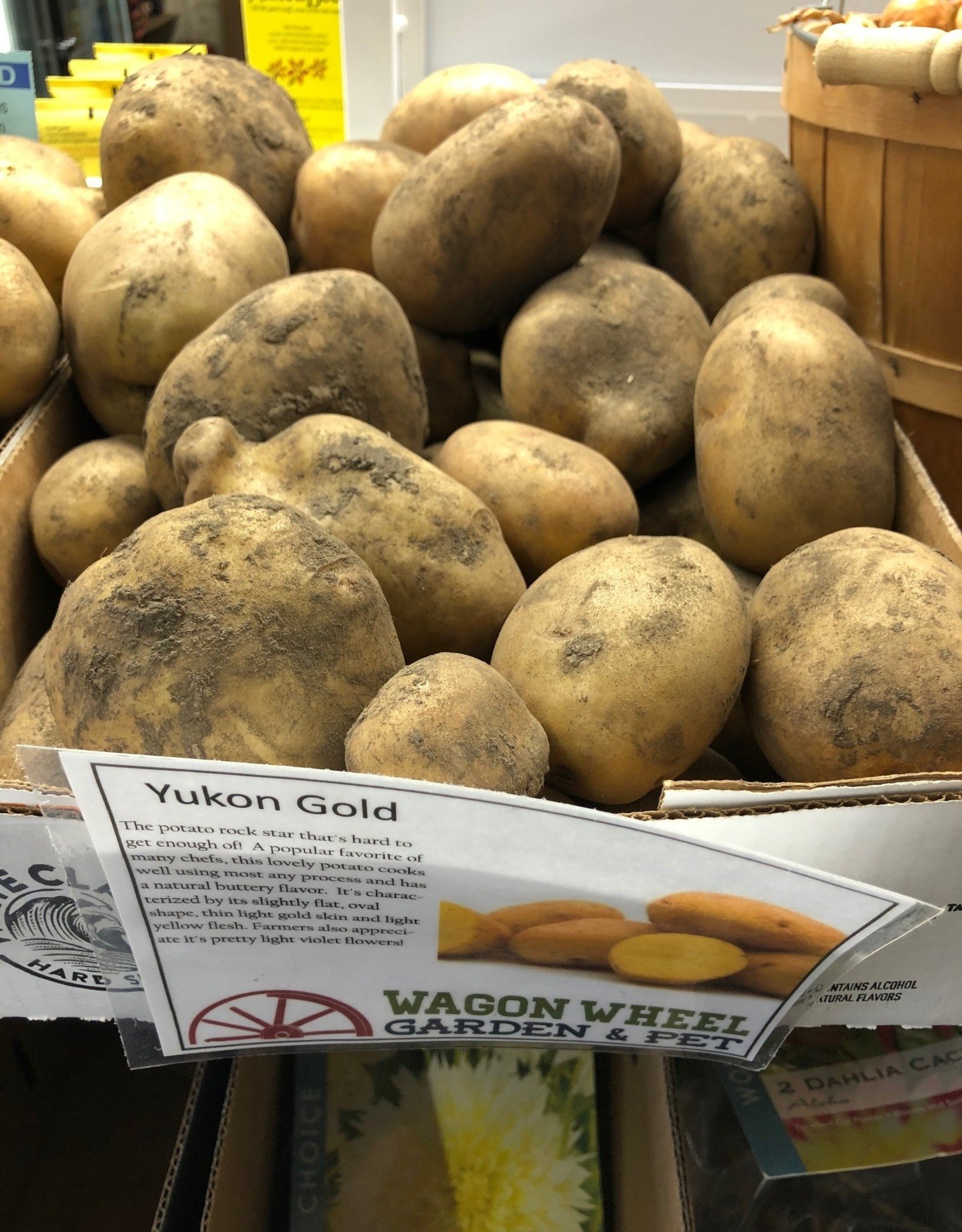Seed Potato per tenths of pound
| Availability: | Out of stock |
Sold by tenths of a pound. For ordering online 1 pound = quantity of 10. This will equal $4.00/lb.
If you want 10lbs, purchase 100. Or another example: If you want 2 and one half pounds, order 25.
When checking out you can let us know the varieties and pounds of each you want in the note section.
Delta Reds (R-22) - Beautiful red potatoes that are quite bright red inside too! At Oceanside Farms we sometimes call them "Donna Reds"! Plant some early and tickle some out for the 4th of July to make patriotic roasted potatoes with purple Magic Mollies and either our Granolas, Yukon Golds, or Yellow Finns!
French Fingerlings - A gourmet quality fingerling with satin red skin and yellow flesh with an interior ring of red when cut across. A mid-season potato that matures in 80-100 days, it produces good-quality, medium sized tubers which are a great addition to any plate. It is said that this fingerling arrived in this country during the 1800's in a horse’s feedbag. We love the creamy texture – and if planted with lots of space they can grow HUGE tubers! According to Mother Earth News, French Fingerlings have 50 times more antioxidants than the common white "Kennebec" potato.
Green Mountain - Famous for its marvelous flavor and exceptional baking qualities. They are good boiled or fried too! An heirloom released in 1885, bred in the Green Mountains of Vermont, but now sourced in Alaska. Produces a high yield of light tan-skinned, white-fleshed tubers that store exceedingly well. The plants display big white flowers. A true potato lover’s potato, baked or boiled - they are unparalleled fluffiness and an authentic earthy flavor that doesn’t fade in long storage. Recently Green Mountain potatoes have joined other historical vegetables and fruits on the Slow Foods “Ark of Taste” list.
Magic Mollies - Alaska Potato Man, Bill Campbell, named the Magic Molly after his daughter. We LOVE the amazing deep PURPLE color thru and thru. Purple veggies are rich in anthocyanins which have been linked to a broad range of health benefits including blocking inflammation, lowering blood pressure, lowering LDL cholesterol, and even helping to preserve memory in people with early stages of dementia. Microwaving preserves the color, and they are good steamed, boiled or baked. We love roasting them with other colored potatoes (think about the 4th of July!)
Robinta - This is high yielding and produces smooth, red skinned potatoes with a creamy light yellow flesh which are oval and short. Robinta potatoes are ideal for baking, roasting, boiling, and mashing and have excellent disease and pest resistance. Some say that it is the most disease resistant potato ever! Locals are loving them!
Yukon Golds Limited Supply - The potato rock star that's hard to get enough of! A popular favorite of many chefs, this lovely potato cooks well using most any process and has a natural buttery flavor. It's characterized by its slightly flat, oval shape, thin light gold skin and light yellow flesh. Farmers also appreciate it's pretty light violet flowers!
Allagash is a mid-season oblong russet potatoDeveloped by (USDA) at the University of Maine to be an all-purpose potato. They are resistant to scab, bruising and skinning.
Info from Oceanside Farms :
Handling your seed potatoes – Place them in an open area for good air circulation. They were in our root cellar, but once taken out will warm up, break dormancy, and start growing! If your potatoes arrive with sprouts, handle them carefully when cutting and planting, leaving the sprouts on. Don’t worry if they break off because they will grow back but do emerge a bit faster when planted with the sprouts in tact.
We do recommend pre-sprouting, a process called "chitting" your potatoes before planting. Our chitting process: About 2 weeks before we intend to plant our potatoes, we spread them out on a tray in a room with medium light and 60-70 degrees. The warmth promotes development of strong sprouts, and the light causes them to stay short and stubby (not weak or easily broken off). This step adds a little more work, but results in quicker tuber development and also heavier yields.
Plant whole and/or cut pieces, leaving 2 or more eyes or sprouts per piece. Seeds can be planted immediately after cutting, but if your soil is wet, we recommend drying the cut pieces (in a shallow open box protected from the sun for 24+ hours) to help guard against the threat of infection by soil-borne bacteria and fungi. Potatoes like a minimum of 6 hours of sunlight, good, healthy compost/fertilizer and about an inch of water/week. They want to grow!
We don't personally "hill" our potatoes throughout the growing season. We grow them outdoors in 2' wide rows under typar, planting 12" on center. We figure that there are 8-10 pieces of potato per pound. This might help you with calculations for your garden space, but there are many other ways that farmers and gardeners successfully grow potatoes. Some homesteaders believe that planting big potatoes will yield big potatoes.
Where do you grow them for best results? It's all about good soil! Soils that are compacted, have poor soil structure, and are low in organic matter, tend to have high incidence of scab. Common scab of potatoes is caused by several species of the bacteria of genus Streptomyces which is common in soils. These bacteria produce a toxin called thaxtomin that disrupts the development of cell walls and results in scab lesions which are not pretty, but you can cut them off and eat the potato. Lime application is tricky. Most agreed that adequate lime spreading to provide calcium and magnesium nutrition is important, but high levels of lime spreading just prior to potatoes may cause some short-term soil chemistry changes that can result in increased scab incidence. Remember, scab is a result of cell wall disruption, so adequate calcium to build strong cell walls may be helpful. Gypsum can also be used to provide calcium nutrition. Hilling is optional, but we really recommend rotating where you grow potatoes from year to year. As far as crop rotations, there has been a lot of research on the use of brassica crops (mustard, canola, rape, broccoli) prior to potatoes that tended to show a reduced incidence of common scab more so than other materials. (Thank you to the folks at the Penn State Extension for some of this information!)










